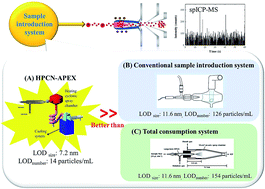Evaluation of three different sample introduction systems for single-particle inductively coupled plasma mass spectrometry (spICP-MS) applications
Abstract
To realize a ∼100% transport efficiency (TE) and a high-throughput sample analysis for nanoparticle characterization using single-particle inductively coupled plasma mass spectrometry (spICP-MS), three sample introduction systems, including a high-performance concentric nebulizer with a heated cyclonic spray chamber and a three-stage Peltier-cooled desolvation system (HPCN-APEX), a conventional sample introduction system (i.e., the commercially available MicroMist nebulizer with a cyclonic spray chamber), and a total consumption (TC) system, were evaluated and compared. The TEs of the HPCN-APEX and TC systems were almost 100% at sample uptake rates of 103 and 9.8 μL min−1, respectively, whereas that of the conventional sample introduction system was only 10% at an uptake rate of 112 μL min−1. Because of the dried aerosol conditions in HPCN-APEX, the size and number detection limits of HPCN-APEX were 1.6-fold and 10-fold lower than those of the TC system. The HPCN-APEX showed better detection efficiency for smaller particles and lower particle numbers. This is beneficial not only for environmental monitoring but also for the ultra-trace analysis of particle impurities in semiconductor process chemicals.



 Please wait while we load your content...
Please wait while we load your content...